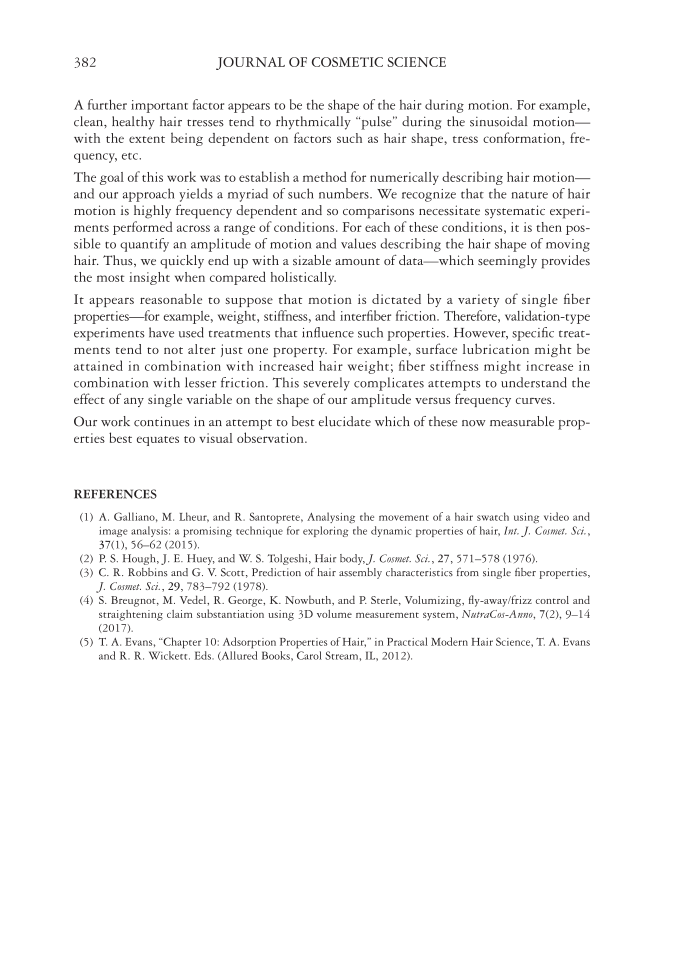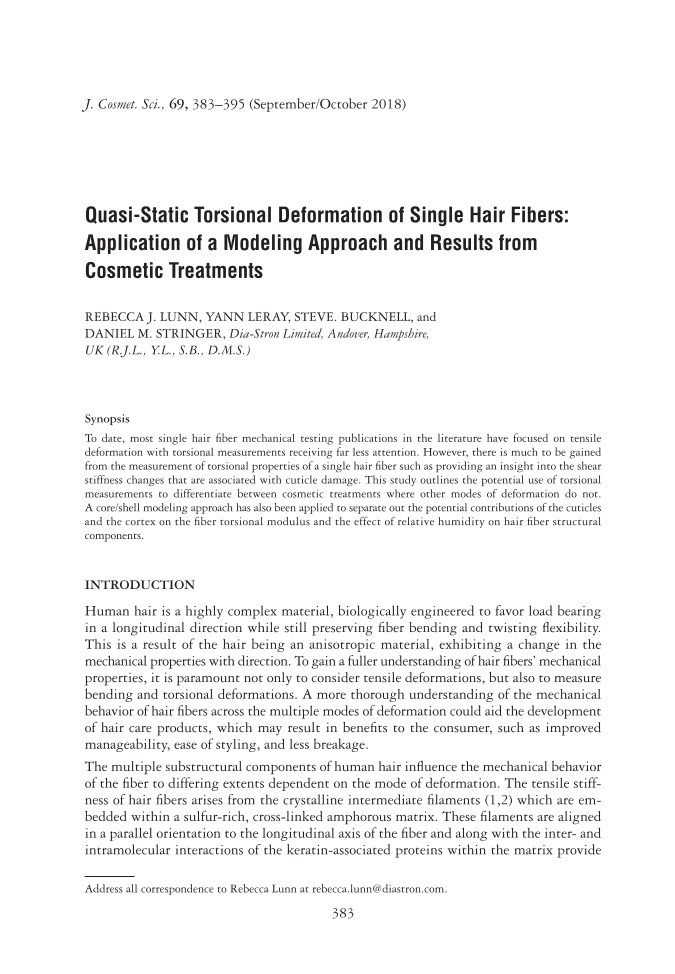JOURNAL OF COSMETIC SCIENCE 382 A further important factor appears to be the shape of the hair during motion. For example, clean, healthy hair tresses tend to rhythmically “pulse” during the sinusoidal motion— with the extent being dependent on factors such as hair shape, tress conformation, fre- quency, etc. The goal of this work was to establish a method for numerically describing hair motion— and our approach yields a myriad of such numbers. We recognize that the nature of hair motion is highly frequency dependent and so comparisons necessitate systematic experi- ments performed across a range of conditions. For each of these conditions, it is then pos- sible to quantify an amplitude of motion and values describing the hair shape of moving hair. Thus, we quickly end up with a sizable amount of data—which seemingly provides the most insight when compared holistically. It appears reasonable to suppose that motion is dictated by a variety of single fi ber properties—for example, weight, stiffness, and interfi ber friction. Therefore, validation-type experiments have used treatments that infl uence such properties. However, specifi c treat- ments tend to not alter just one property. For example, surface lubrication might be attained in combination with increased hair weight fi ber stiffness might increase in combination with lesser friction. This severely complicates attempts to understand the effect of any single variable on the shape of our amplitude versus frequency curves. Our work continues in an attempt to best elucidate which of these now measurable prop- erties best equates to visual observation. REFERENCES (1) A. Galliano, M. Lheur, and R. Santoprete, Analysing the movement of a hair swatch using video and image analysis: a promising technique for exploring the dynamic properties of hair, Int. J. Cosmet. Sci., 37(1), 56–62 (2015). (2) P. S. Hough, J. E. Huey, and W. S. Tolgeshi, Hair body, J. Cosmet. Sci., 27, 571–578 (1976). (3) C. R. Robbins and G. V. Scott, Prediction of hair assembly characteristics from single fi ber properties, J. Cosmet. Sci., 29, 783–792 (1978). (4) S. Breugnot, M. Vedel, R. George, K. Nowbuth, and P. Sterle, Volumizing, fl y-away/frizz control and straightening claim substantiation using 3D volume measurement system, NutraCos-Anno, 7(2), 9–14 (2017). (5) T. A. Evans, “Chapter 10: Adsorption Properties of Hair,” in Practical Modern Hair Science, T. A. Evans and R. R. Wickett. Eds. (Allured Books, Carol Stream, IL, 2012).
J. Cosmet. Sci., 69, 383–395 (September/October 2018) 383 Quasi-Static Torsional Deformation of Single Hair Fibers: Application of a Modeling Approach and Results from Cosmetic Treatments REBECCA J. LUNN, YANN LERAY, STEVE. BUCKNELL, and DANIEL M. STRINGER, Dia-Stron Limited, Andover, Hampshire, UK (R.J.L., Y.L., S.B., D.M.S.) Synopsis To date, most single hair fi ber mechanical testing publications in the literature have focused on tensile deformation with torsional measurements receiving far less attention. However, there is much to be gained from the measurement of torsional properties of a single hair fi ber such as providing an insight into the shear stiffness changes that are associated with cuticle damage. This study outlines the potential use of torsional measurements to differentiate between cosmetic treatments where other modes of deformation do not. A core/shell modeling approach has also been applied to separate out the potential contributions of the cuticles and the cortex on the fi ber torsional modulus and the effect of relative humidity on hair fi ber structural components. INTRODUCTION Human hair is a highly complex material, biologically engineered to favor load bearing in a longitudinal direction while still preserving fi ber bending and twisting fl exibility. This is a result of the hair being an anisotropic material, exhibiting a change in the mechanical properties with direction. To gain a fuller understanding of hair fi bers’ mechanical properties, it is paramount not only to consider tensile deformations, but also to measure bending and torsional deformations. A more thorough understanding of the mechanical behavior of hair fi bers across the multiple modes of deformation could aid the development of hair care products, which may result in benefi ts to the consumer, such as improved manageability, ease of styling, and less breakage. The multiple substructural components of human hair infl uence the mechanical behavior of the fi ber to differing extents dependent on the mode of deformation. The tensile stiff- ness of hair fi bers arises from the crystalline intermediate fi laments (1,2) which are em- bedded within a sulfur-rich, cross-linked amphorous matrix. These fi laments are aligned in a parallel orientation to the longitudinal axis of the fi ber and along with the inter- and intramolecular interactions of the keratin-associated proteins within the matrix provide Address all correspondence to Rebecca Lunn at rebecca.lunn@diastron.com.
Purchased for the exclusive use of nofirst nolast (unknown) From: SCC Media Library & Resource Center (library.scconline.org)









































































































